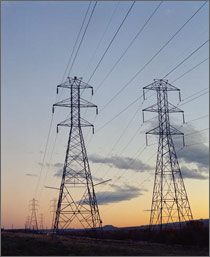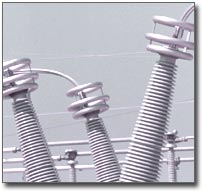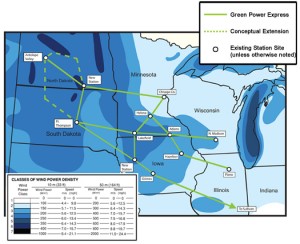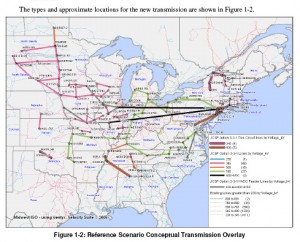Xcel’s $$$ strategy approved
January 17th, 2011
This came up when our house deal was making life complicated, and then I was off in Colorado, so I didn’t get it posted, now it’s time to catch up!
Xcel went to the PUC for changes in its Capital Organization wiggle-room, and got what they wanted, with some additional reporting requirements.
What I’m noticing is that something like this that ‘s SO important, like the Otter Tail Power “Standstill Agreement,” and like the Otter Tail Power “Standstill Agreement,” there’s enviro silence. Nobody is on this… why?
Xcel Request – 2011 Capital Organization – Part I
Xcel Request – 2011 Capital Organization – Part II
Thankfully Bob Geiger, Finance & Commerce, was:
Utilities fielding $2B in projects for 2011
Posted: 5:17 pm Fri, January 7, 2011
By Bob GeigerWind, transmission line projects part of busy year for power providers
According to documents filed with the MPUC, Xcel plans to pay for the capital projects with short-term debt and multiyear credit agreements, a $300 million long-term debt issue in the third quarter and $190 million in cash.
Read the rest of this entry »
Susquehanna-Roseland Intervenor Testimony!
July 17th, 2009
It’s here, the testimony of the Intervenors against PSE&G’s Susquehanna-Roseland transmission project, well, it was last week, and FINALLY I’m getting around to posting it.
STOP THE LINES needs donations to keep up the fight. Donations can be made by check payable to: Stop The Lines PO Box 398 Tranquility NJ 07879. You can also use paypal — just go to STOP THE LINES and scroll down.
Tax-deductible checks are also accepted, made out to “NJ Highlands Coalition”, and put “Stop The Lines” in the memo
Mail to: NJ Highlands Coalition, ATT: Stop The Lines, 508 Main St. #3, Boonton NJ 07005
*************************
COALITION OF TOWNS
Exhibits will take a while — there are a LOT
BKS-1 – PEC Motion to VA Supreme Court
BKS-5 – PSEG 2009 Q1 Earnings Call Transcript
BKS-7 – Rosengren Reuters June 5, 2009
BKS-8 – PEPCO PR MAPP May 19, 2009
BKS-10 – Rebecca Smith, Wall Street Journal
FREDON PALS & WILLOW DAY CAMP
JCSP & UMTDI in the news
February 16th, 2009
More transmission – again in the Wall Street Journal.
Hard to tell which of the alphabet soups this article is about, and I’d say both, it’s about the Joint Coordinated System Plan and the Upper Midwest Transmission Development Initiative — UMDTI! But we know it’s all one and the same.
The article doesn’t really specifically name either “group” and it leaves us wondering just who or what is behind it. This is a good thing — yes, it really is as amorphous as it sounds! What disturbs me, of course, is the “It’s for wind,” because we know better!
At least the WSJ noticed the NYISO and ISO-NE’s objections — here it is again, it’s one of those letters I just can’t get enough of:
The UMDTI is insidious, a cheerleading effort to push transmission through. The way the thing is structured, is, as I said in my comments at the February 11, 2009, meeting, is ABSOLUTELY ASS-BACKWARDS. It’s market driven backwards engineering a transmission solution to support nonexistent need.
Upper Midwest Transmission Development Initiative – HOME PAGE
UMTDI Stakeholder Letter 10-28-08
Stakeholder Responses – LINK – look who the stakeholders are – DUH!
Wind on the Wires Comments … sigh…
UMDTI Stakeholder Letter 12-31-08 (Ed Garvey – MISO)
Dec 30 Draft – Cost Allocation Work Group (Marya White – Commerce)
December 30 Draft – Transmission Planning Work Group (Randy Pilo – PSC-WI)
Wind on the Wires cites many studies:
MISO’s Regional Generation Outlet Study (RGOS)
Transmission planning initiatives by” CapX 2020, ATC, Mid-American and others”
Minnesota RES transmission study
MISO’s MTEP-08 and MTEP-09
Joint Coordinated System Planning Stuey
Eastern Wind Integration Transmission Study
None of these studies are linked — and they’re not on the UMTDI site — let’s see how long it takes to find them.
Now for the more difficult ones… one moment please…
TRANSLink… er… “Green Power Express”
February 10th, 2009
Here we go, the Green Transmission Machine is here and is trying to leave the station, and what a crock. ITC Holdings, transmission only company a la TRANSLink, has announced “The Green Power Express” and here’s their press release:
And look at this map, here it is:
Once again, they’re saying “it’s GREEN” from wind in Dakotas to Chicago… oh, but doesn’t it start in ANTELOPE VALLEY? Isn’t that where all those coal plants are? Isn’t that where they want to build new coal plants? And isn’t Illinois the state where they have thousands of MW of wind in the MISO queue? And for this we should give them $10-12 BILLION to build this? I don’t think so…
And while you’re at it, this is MTEP, so check this out the JCSP/MTEP plan:
Here’s the upshot of what they’re proposing:
All of this is tied in with the “Upper Midwest Transmission Development Initiative” which is a bunch of utility transmission oriented folks who have a lot to gain from this, Governors lead by Pawlenty the utility toadie, and regulators who don’t seem to be able to think their way out of a box — they’re promoting transmission without addressing need, claiming a transmission solution for a problem that doesn’t exist:
FINAL UMTDI MEETING TOMORROW
FEBRUARY 11, 2009
1:30-3:00 p.m.
PUC Large Hearing Room
3rd Floor
121 – 7th Place East
St. Paul, Minnesota
What dries me crazy is that this so obviously isn’t necessary, because there’s SOOOOO much wind already in Illinois and here’s the MISO queue, in Excel and sortable, for your edification:
Here’s an ILL WIND for this project, sorted from above MISO Queue (note that some of that 11,281MW is already in service):
But this is all about the MISO Midwest Market and displacing natural gas with coal:
ICF’s Independent Assessment of Midwest ISO Operational Benefits
In Milwaukee Journal Sentinal:
Here’s the STrib article about the Green-with-Nausea Power Express:
Huge power line may be coming to Minnesota
In Grist today: Transmission Lies
February 3rd, 2009
Against the so-called ‘need’ for new long-distance, high-voltage transmission lines
Posted by Guest author (Guest Contributor) at 10:31 AM on 03 Feb 2009

Transition … transmission … transition … transmission …
That old Bowie hook is on my mind as I represent individuals, community organizations, and local governments opposing high-voltage transmission lines. Today we’re at a crossroads in energy, a transition point where the decisions we make, like electricity itself, are binary. What we choose will determine how we use electricity in the future. The first step is to carefully define “need.”
Transmission doesn’t produce electricity. It is passive infrastructure that just sits there, conducting energy from one place to another. At its worst, though, it’s an enabler of dysfunctional energy planning and profit-driven projects that are against the public interest. Claims that we “need” transmission are end-stage conclusions of a many-step planning process that we as a society have not yet consciously begun.
“Need” is a term of art, and the crucial task for energy planners is to define the need. We need energy when we flick the switch, and when we do, that’s a utility’s need for service of local electrical load. We also need renewable generation, and we have an equally compelling need to reduce the CO2 emissions, pollutants, and toxic waste of electrical generation (a need not readily recognized in energy planning). Energy planners plan for peak “flick of the switch” need, those few very hot summer days or very cold winter nights. How much “flick of the switch” energy do we need? It depends.
Prior to assessing local load-serving need and making demand projections — before “need” is considered — the first and unarguably least-cost step is conservation. We can easily make up for an annual projected increase in demand of 1.5 percent through conservation, and can probably cut today’s “need” by 10 percent or more, though compound conservation gets more difficult as we cherry pick the easy stuff. The next step before analyzing need is to enact energy efficiency, demand-side management, and load-shifting to cut the peaks and level out the dips. This is also a comparatively least-cost means of meeting demand.
When that’s done, and not before, it’s time to assess our need for electricity — the supply side. Utilities, which are in the business of selling electricity and building their infrastructure — for which we pay, routinely promote sales and exaggerate growth in demand. Because of their overstatements of need in similarly recessionary times, we overbuilt in the 1970s, to the extent that many proposed plants were ultimately canceled. Still so much was built that we haven’t needed much utility infrastructure since. We’ve been through this before, and should be mindful in making investments.
Because of the recent utility industry shift to market-based dispatch, whereby generation is no longer strictly for service of local load but for wider regional or national electricity markets, market expansion has become the driver for the utility “need” for transmission. This is the key difference: how much transmission utilities need to serve their local load (the public good) vs. how much they need to participate in markets (greater profits). North American Electric Reliability Corporation (NERC), the private overseer of all things transmission, admits in Reliability Assessments that there is a lot of new electrical generation planned and that the transmission system is sufficient to meet local load-serving needs. The confounding factor: NERC notes that the transmission grid is constrained in places and is not sufficient for market purposes, for market expansion.
The short explanation of the shift to market focus is that, in theory, it makes generation available to all who want it, based on price rather than location. The cheapest is sold first, and buyers queue up in line. But the sale price is busbar price at the generator or seller, and does not take into account the costs of getting it from here to there — notably transmission construction, transmission service, and line loss. These costs are tacked on and billed to the purchasing utility, and will be added to the customer’s bill. The market “price” thus appears misleadingly low. Cheap coal-generated electricity from West Virginia looks awfully good to buyers in New Jersey when all the costs aren’t factored in to the sale price.
This is the crucial point: The divergence between traditional “local load-serving need” and the desire of utilities to beef up need claims, to build generation and transmission at ratepayer expense, in order play the market. State regulatory proceedings are couched in traditional “local load-serving need” terms, and utilities must prove up need before they are granted Certificates and proceed with construction. Investments must be “reasonable and prudent.” Opportunity to play the market is not reasonable and prudent, so it’s not a reason to build a transmission line — utility desire to increase market transactions is not recognized as “need” in a Certificate of Need or Certificate of Public Convenience and Necessity proceeding. This is where transmission lines become transmission lies: Transmission projects for market trading are couched in terms recognized by regulators.
Planning for “peak load” is a transmission lie. Utilities have incentive to overstate “need” when they build for peaks. The higher the peak they build for (with peak occurring only several times annually), the deeper the off-peak valley and the more electricity they can sell on the market when generation is available but not “needed.” Conservation and peak-shaving is against their interest because it lowers peak and lessens the valley of market sales.
“We’ll have blackouts” and “we’re going to freeze in the dark” are transmission lies. A review of recent blackouts — the ones used to justify transmission projects — shows that they occurred during off-peak times where utilities were overloading the lines, pushing more electricity than the system could handle. Despite warnings that the system was at risk, operators did not cut back on loading. An industry report on one blackout during “light load condition and low cost Mid-Continent Area Power Pool (MAPP) generation,” while “there were high simultaneous exports,” concluded:
This event should not be filed away as just another close call. We need to recognize just how close we were to collapsing portions of the Eastern Interconnection and adjust operating guides and reporting practices to avoid recurrence. There are real limits to the transfer capability out of the MAPP region and those limits are interdependent. This event is an alarming representation of how the MAPP regional interconnected system is being operated at and even beyond its capabilities.1
Utility “forecasts” are a lie. Despite their propensity to overstate need, several utility CEOs recently admitted that use has decreased from 3-9 percent, and that future infrastructure projects should be reconsidered. If we’ve moved from 1.5-2 percent projected growth to 3-9 percent decrease — with no increase in sight — that 4.5-11 percent drop in forecasted demand will substantially alter projections for years to come. The longer that drop continues, the further out it will affect projections. Despite this change in use and extension of “need” out in time, utilities are holding on to outdated projections. They still want to build infrastructure based on inflated “need,” infrastructure that we will pay for — and pay them a percentage return on investment. If approved, utilities will cover costs and make a return whether it is needed or not.
“It’s for renewable generation” is a lie. The massive transmission infrastructure expansion proposed is not “for renewables” because transmission may not discriminate by generation type. Federal regulations prohibit discrimination among generators — it’s first come, first ready, first served. There are tens of thousands of megawatts of coal projects, with transmission studies complete or in progress, waiting for interconnection, and whatever generation is ready will be connected. Another side of this lie is when wind advocates support transmission, claiming “it’s for renewables,” and ignore the impacts of transmission on the communities it traverses. Rather than make this convoluted “it’s for renewables” claim, there’s a better way: if renewable energy mandates were directly linked with shut down of fossil generation, and if renewable generators were thoughtfully sited, both the electricity market and transmission infrastructure would be open and available.
“Long distance transmission” is a lie. Transmission is inherently inefficient over long distances. Transmission physics entails high levels of line loss, and the longer the line, the higher the line loss. To avoid this fact of physics, the electric industry has shifted its line loss analysis for new projects to a “system wide” loss, so the numbers look low. But consider actual numbers of megawatts of line loss, and look at “coal plant equivalents” to make up that loss — for every 500-600 MW of line loss, a coal plant or more would have to be built! Line losses are charged in Federal Energy Regulatory Commission rates, but this is not considered directly in the market transactions. Line loss is an afterthought add-on to the customer’s bill after transmission service is provided. Consider too the capital cost of transmission, starting at about $1.5 million per mile for 345kV lines and upward from there.
Utilities’ frame of “need” for “public purpose” is a lie. Most transmission regions of the country are now planning transmission expansion to make their markets workable — to be able, theoretically, to ship power across the country. For example, in the Midwest, it’s the Midwest Transmission Expansion Plan. In PJM on the east coast, it’s the Regional Transmission Expansion Plan. These plans are all market-based, but for those transmission projects in states that regulate transmission, they’ll couch “need” in terms recognized by the state to get the approvals they need.
For example, CapX 2020 in the Midwest is framed for Minnesota regulators as needed for “local load-serving,” “regional reliability,” and “generation interconnection” — despite being an obvious expansion for coal through Minnesota to points east. The Mid-Atlantic Power Pathway is framed as necessary to serve local load in the Delmarva peninsula, despite being an obvious pass-through from West Virginia coal to New Jersey, connecting major power plants for export to the Northeast. Utility framing of this market-based, profit-based purpose as public purpose “need” also serves as their basis for taking land through eminent domain, because a corporation’s private purpose is expressly prohibited as justification for a taking.
Will we fall for transmission lies? Is new transmission a public purpose, a public need, provision of an essential service for a utility’s service area? Or is it an industry grab for market opportunities and profits at the public’s expense?
In my years of practice, I’ve yet to see a transmission line actually meant for the “need” proposed. We must take a critical look at these projects’ claims, because we’re the ones who will pay, and the lines will go over our land. Odds are, it’s private-purpose infrastructure that commits us to 50 or more years of wrongheaded, inefficient, and polluting central-station generation.
Electricity is binary, as is our situation now — we’re at a point where we must choose our path.
(Special thanks to electrical engineers Art Hughes, David Blecker, and Rick Gonzalez for making me learn about losses, planning, need, and powerflows.)
—–
1 Nebraska Public Power District, Report on June 10-11, 1997 Disturbance. See also Northern MAPP/Northwestern Ontario Disturbance — June 25, 1998 — Final Report; NERC Investigation of August 14, 2003 blackout.


